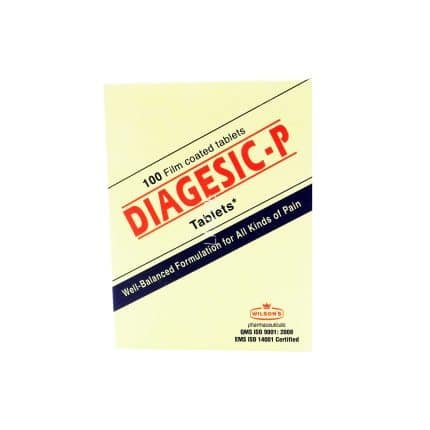Diagesic P Tablet is a combination medication containing Dextropropoxyphene & Paracetamol as active ingredients. Dextropropoxyphene belongs to the class of medications known as opioid analgesics, primarily used to relieve mild to moderate pain. Paracetamol, also known as acetaminophen, is a pain reliever and fever reducer. This combination medication is used to provide relief from pain and discomfort.
Uses: Diagesic P Tablet is indicated for:
- Relief of mild to moderate pain such as headache, toothache, menstrual cramps, muscle aches, and back pain.
- Reduction of fever associated with various conditions such as cold, flu, or infections.
Dosage and Administration:
- The dosage of Diagesic P Tablet may vary depending on the severity of pain and the patient’s medical condition.
- It is usually taken orally, with or without food, as directed by a healthcare professional.
- Swallow the tablet whole with a glass of water. Do not crush or chew the tablet.
- Follow the prescribed dosage and administration schedule carefully to achieve optimal pain relief.
Precautions:
- Diagesic P Tablet should be used with caution in patients with a history of liver or kidney disease, alcoholism, or drug abuse.
- Avoid consuming alcohol while taking Diagesic P Tablet, as it may increase the risk of liver damage or other adverse effects.
- Inform your healthcare provider about all medications you are currently taking, including prescription, over-the-counter, herbal, or dietary supplements, before starting treatment with Diagesic P Tablet.
Side Effects: Common side effects of Diagesic P Tablet may include:
- Nausea or vomiting
- Dizziness or lightheadedness
- Drowsiness
- Constipation
- Dry mouth
Less common but more serious side effects may include:
- Allergic reactions such as rash, itching, or swelling
- Liver or kidney problems
- Difficulty breathing or slowed heartbeat
If any adverse reactions occur or persist, discontinue use and consult a healthcare professional.
Interactions: Diagesic P Tablet may interact with certain medications, including other opioids, sedatives, tranquilizers, and antidepressants. Inform your healthcare provider about all medications you are currently taking to avoid potential drug interactions.
Tags: Diagesic P Tablet, Dextropropoxyphene, Paracetamol, pain relief, fever reducer.
FAQ:
- How does Diagesic P Tablet work?
- Diagesic P Tablet works by blocking pain signals in the brain and spinal cord, thereby reducing the perception of pain. Paracetamol also acts on the brain to reduce fever.
- Can Diagesic P Tablet be used for long-term pain management?
- Diagesic P Tablet is not recommended for long-term use or chronic pain management due to the risk of addiction, dependence, and other adverse effects. Consult a healthcare professional for alternative treatment options for chronic pain.
- Is Diagesic P Tablet safe during pregnancy or breastfeeding?
- Consult a healthcare professional before using Diagesic P Tablet during pregnancy or breastfeeding to assess the potential risks and benefits.
- Can Diagesic P Tablet be used in children?
- Diagesic P Tablet is not recommended for use in children without medical supervision. Consult a healthcare professional for appropriate dosage and administration instructions for pediatric patients.
- What should I do if I accidentally take more than the prescribed dose of Diagesic P Tablet?
- If you accidentally take more than the prescribed dose of Diagesic P Tablet, seek immediate medical attention or contact a poison control center for advice. Overdose may result in serious adverse effects, including liver damage or respiratory depression.






Reviews
There are no reviews yet.